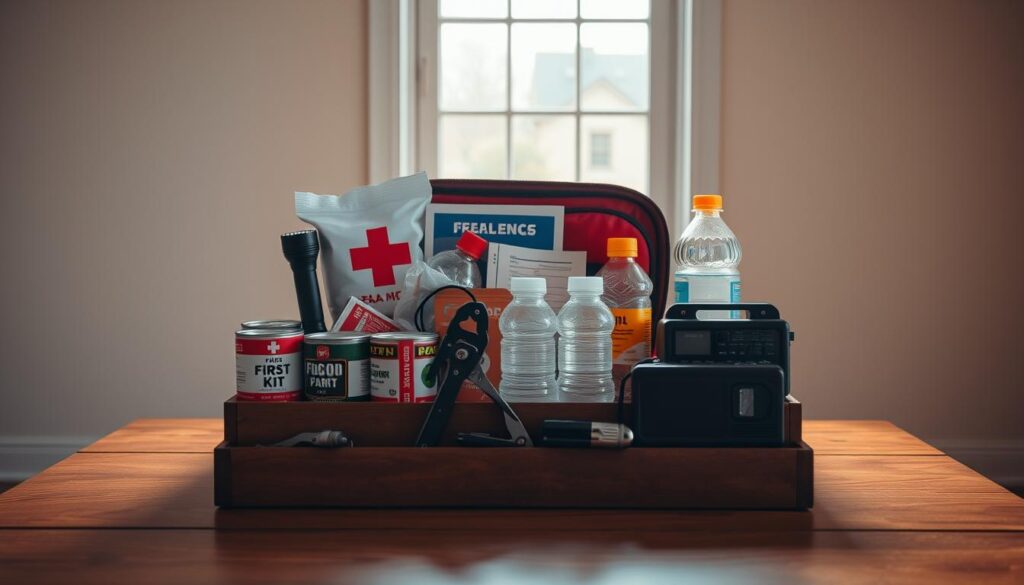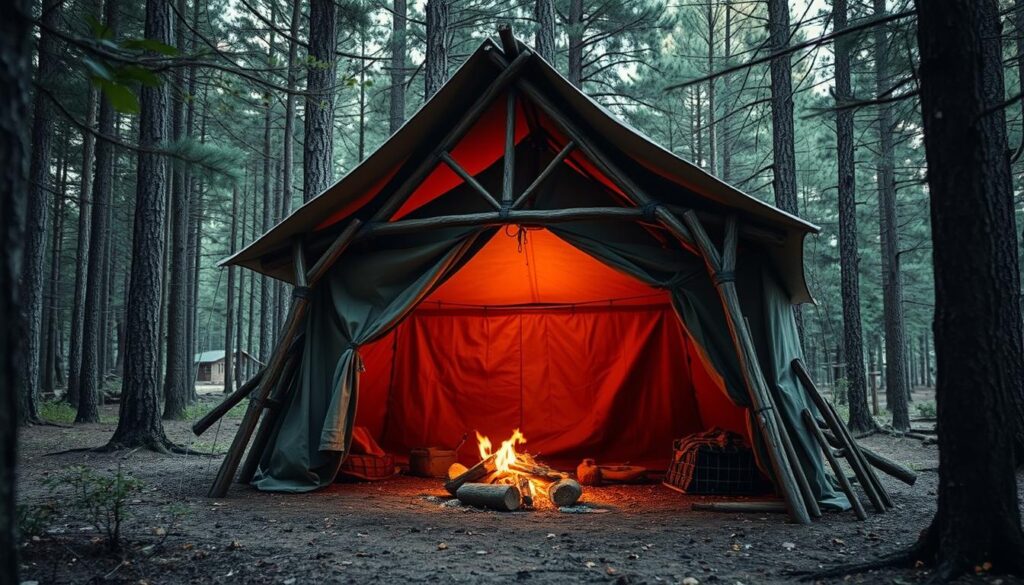Being ready for the unexpected is key in our lives. It’s important to have basic items that can help us in emergencies. I remember a time when a disaster preparedness kit really helped me get through a tough spot.
Having your own food, water, and other important supplies can save your life in disasters. A disaster supplies kit is a must for emergency preparedness. It makes sure you and your family are ready for any surprise.
In this guide, I’ll show you how to make a full shelter emergency kit. By following this guide, you’ll be more ready for emergencies. You’ll also keep your loved ones safe and sound.
Key Takeaways
- Understand the importance of having a disaster supplies kit.
- Learn how to create a full shelter emergency kit.
- Find out what essential items to put in your emergency kit.
- See the good things about being ready for emergencies.
- Start making your own disaster preparedness kit today.
What is a Shelter Emergency Kit?
A shelter emergency kit is key for disaster readiness. It’s a set of essential items that help people survive and recover from disasters. It’s designed for families and individuals to stay safe.
Understanding the definition and importance of a shelter emergency kit is vital. It provides basic needs like water, food, and first aid during emergencies. This kit is a lifeline when help is needed most.
Definition and Importance
The emergency shelter kit is more than just supplies. It’s a lifeline in critical times. It keeps people safe until help arrives or the situation gets better.
For more info on building an emergency kit, check out https://www.ready.gov/kit. It has detailed guides on emergency preparedness.
Key Components of the Kit
An emergency survival kit includes water, non-perishable food, a battery-powered radio, flashlight, first aid kit, and extra batteries. These items meet basic human needs like hydration, nutrition, safety, and medical care.
Knowing what disaster shelter supplies are needed is important. For example, a first aid kit treats minor injuries. A battery-powered radio gives updates and information during emergencies.
With these essential supplies, an emergency shelter kit boosts one’s ability to handle emergencies.
Assessing Your Needs
To create a shelter in place kit that fits your needs, start by understanding your environment and family. This step is key to making your emergency kit effective against the challenges you might face.
Understanding Your Environment
Your location affects the emergencies you might face. For example, if you live in a hurricane-prone area, your kit should include items for storm survival.
Think about the natural disasters and emergencies in your area. Plan your kit with items that help protect against these disasters.
Evaluating Family Size and Pets
The size of your family and pets is important for your emergency relief supplies. A bigger family means more food and water.
Consider special needs for infants or seniors. This could include diapers, formula, and medications.
| Family Member | Special Considerations |
|---|---|
| Infants | Diapers, formula, baby food |
| Seniors | Medications, mobility aids, comfortable clothing |
| Pets | Pet food, water, medication, leash |
For more help on emergency kits, visit the California Department of Public Health’s website. They have lots of resources and tips.
“Preparedness is not just about having the right equipment; it’s about having a plan and knowing how to execute it when it matters most.”
Essential Supplies to Include
Building an emergency shelter kit is key. It must have supplies to keep you and your family safe during disasters.
Food and Water Provisions
It’s important to have non-perishable food. Aim for a three-day supply for each person. Choose high-calorie foods like energy bars, canned goods, and dried fruits. Remember to include a manual can opener.
Water is also critical. Store at least one gallon of water per person per day. For a family of four, that’s 12 gallons for three days.
First Aid Supplies
A good first aid kit is essential. It helps with minor injuries and prevents infections. Include bandages, antiseptic wipes, pain relievers, and any needed prescription drugs.
Adding a first aid manual is wise. It teaches you basic medical skills.
Tools and Equipment
The right tools are vital in emergencies. Carry a multi-tool or pocket knife, a flashlight, and extra batteries.
A portable radio and a whistle are also important. They help you stay informed and signal for help.
| Supply Category | Essential Items | Recommended Quantity |
|---|---|---|
| Food | Non-perishable items, energy bars, canned goods | 3-day supply per person |
| Water | Drinking water | 1 gallon per person per day |
| First Aid | Bandages, antiseptic wipes, pain relievers | 1 kit per family |
| Tools | Multi-tool, flashlight, extra batteries | 1 set per family |
Food and Water Considerations
Food and water are key in any emergency kit, like those for shelter-in-place situations. When making your shelter in place kit, pick items that will keep you and your family fed for a while.
Selecting Non-Perishable Food Items
Choosing the right food means picking non-perishable items that are full of nutrients and last long. Think about adding:
- Canned goods (vegetables, fruits, meats)
- Dried legumes (beans, lentils)
- Nuts and seeds
- Dried fruits and vegetables
- MREs (Meals Ready to Eat)
These foods are tough and give you the energy and nutrients you need. Don’t forget to think about any special diets in your family, like gluten-free or lactose intolerant.
Storing Water Safely
Water is vital in your emergency essentials kit. Aim to have at least one gallon per person per day for drinking, cooking, and staying clean. Use airtight containers to keep water fresh.
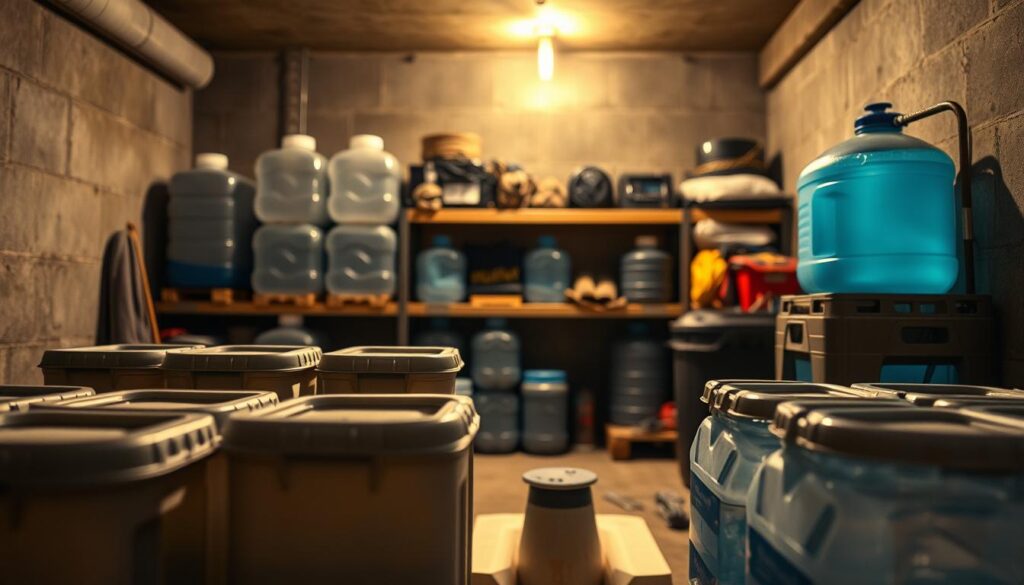
- Use food-grade water containers.
- Store water in a cool, dark place.
- Rotate your water supply every six months.
- Consider using water purification tablets or filters as an additional safety measure.
By paying attention to these details, you can make sure your shelter emergency kit is ready for your family’s needs in a crisis.
First Aid Kits: What to Include
A first aid kit is key in any emergency shelter kit. It has the tools to treat injuries and manage health issues during emergencies.
When making a first aid kit, think about the medical supplies and personal meds you might need. Include both over-the-counter and prescription meds. Also, add items for treating wounds and injuries.
Necessary Medical Supplies
A good first aid kit has many medical supplies. You’ll need bandages, antiseptic wipes, and pain relievers. These items help with minor injuries and stop infections.
- Bandages and band-aids
- Antiseptic wipes and ointments
- Pain relievers and antihistamines
- Gauze pads and rolls
- Medical tape
Here’s a table of essential medical supplies for your first aid kit:
| Supply | Description | Quantity |
|---|---|---|
| Band-aids | Assorted sizes for minor cuts | 20-30 |
| Antiseptic Wipes | For cleaning wounds | 10-20 |
| Gauze Pads | For dressing wounds | 5-10 |
Personal Medications
Don’t forget to add personal medications to your first aid kit. This includes prescription meds for chronic conditions and over-the-counter pain relievers.
Keep personal meds in their original packaging and check expiration dates. It’s smart to include a list of medications, dosages, and instructions.
With both medical supplies and personal medications, your first aid kit will be ready for emergencies.
Tools and Equipment
In an emergency, the tools and equipment in your shelter are key to survival and comfort.
The right tools can help you tackle many challenges. This includes fixing structures and navigating dark places. It’s important to have items that are versatile, durable, and easy to use.
The Importance of Multi-tools
A multi-tool is a must-have in any emergency kit. It has many functions like knives, pliers, and screwdrivers all in one. This makes it very useful when you have to do many things at once.
I suggest adding a top-notch multi-tool to your emergency kit. Choose one that’s made to last and has lots of functions.
Recommended Lighting Solutions
Lighting is also very important in your shelter emergency kit. A good flashlight can light up your space when it’s dark. Pick a flashlight that runs on batteries and lasts a long time. Don’t forget to include extra batteries so your flashlight keeps working.
When picking a flashlight, look for one that’s tough, water-resistant, and has adjustable brightness.
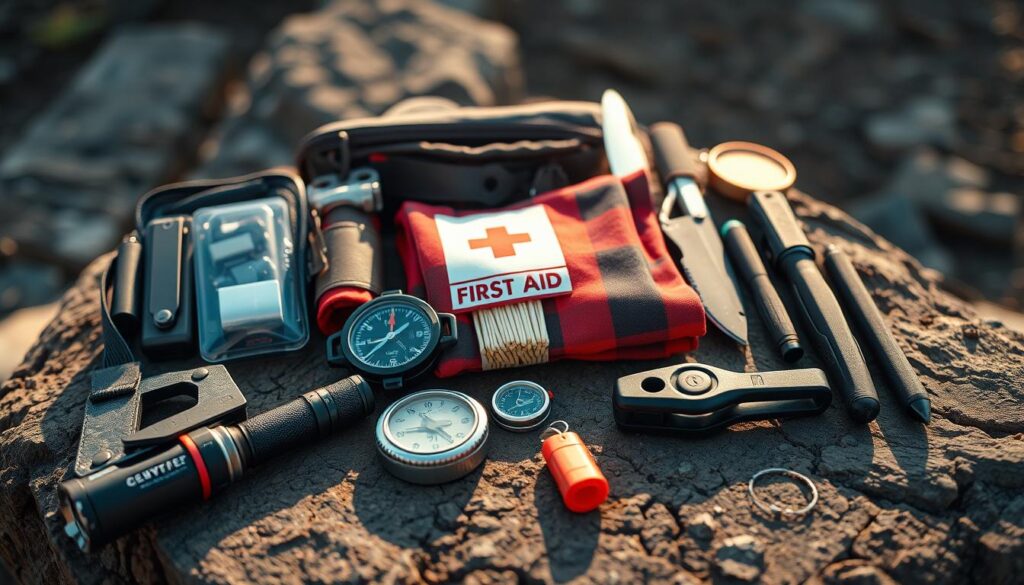
| Tool/Equipment | Purpose | Recommendation |
|---|---|---|
| Multi-tool | Performs multiple tasks | Include a high-quality, durable multi-tool |
| Flashlight | Provides light | Choose a battery-powered flashlight with adjustable brightness |
| Extra Batteries | Ensures continued use of flashlight | Include extra batteries for your flashlight |
Preparing for Unique Situations
Building a shelter emergency kit means thinking about special needs in unique situations. This includes natural disasters or emergencies that need different plans based on where you are.
It’s key to know that different emergencies need different preparations. For example, a hurricane is very different from a wildfire or earthquake. When preparing, think about the disasters common in your area. Then, make your emergency preparedness kit fit those needs.
Shelter Kits for Natural Disasters
For natural disasters like hurricanes, earthquakes, and floods, your kit needs specific items. In hurricane-prone areas, it’s important to have non-perishable food, water, and a first aid kit. You can learn more about making an emergency shelter in this step-by-step guide.
| Disaster Type | Essential Items |
|---|---|
| Hurricanes | Non-perishable food, water, first aid kit, battery-powered radio |
| Earthquakes | First aid kit, flashlights, multi-tool, emergency blanket |
| Floods | Waterproof bags, water purification tablets, dry clothing |
Urban vs. Rural Needs
Urban and rural areas have different needs for your shelter emergency kit. Urban areas might need more masks and communication tools because of possible damage. Rural areas might focus on water purification and more food because help might take longer to arrive.
“The best preparation is having a plan and the right equipment to face whatever comes your way.”
By understanding these differences and tailoring your kit, you can better prepare for emergencies. This helps keep you and your family safe.
Budgeting for Your Emergency Kit
Building an emergency kit doesn’t have to be expensive. Most items needed are cheap and easy to find. By watching your spending and focusing on what’s most important, you can make a great kit without spending a lot.
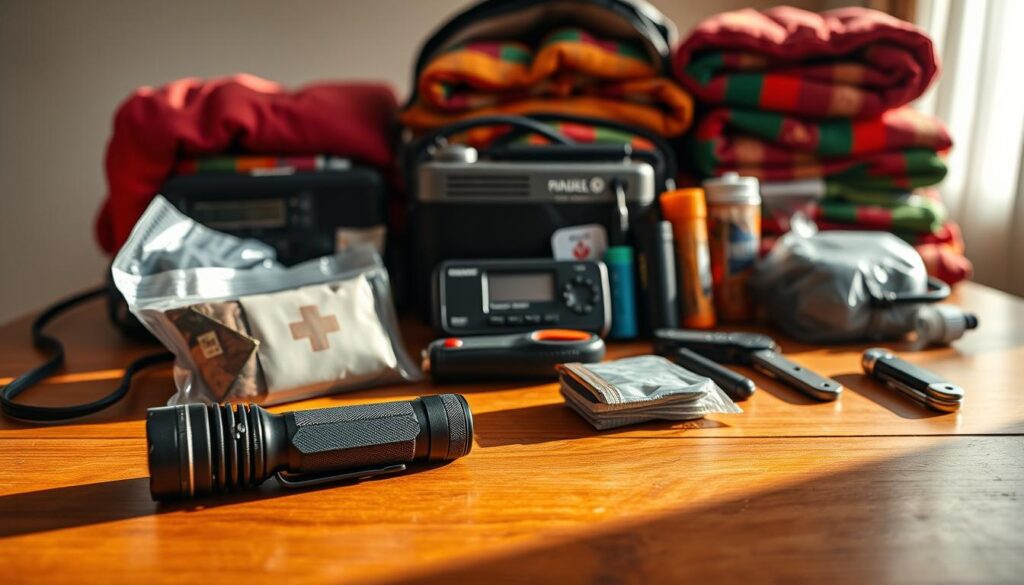
How to Save Costs
To save money, buy items in bulk and choose multi-purpose tools. For example, a multi-tool can replace many single-use items. This saves money and space in your kit. Also, look for sales and discounts on food and supplies.
Building your kit over time is another smart move. Instead of buying everything at once, set aside a little money each month. This way, you can afford it and keep track of when things expire.
Prioritizing Essential Items
When budgeting, focus on the most important items first. These include water, non-perishable food, and first aid supplies. These are key for survival during a disaster.
By focusing on what’s essential and being careful with your budget, you can make a great emergency kit. The goal is to be prepared, not to spend too much.
Maintenance and Updating Your Kit
Keeping your emergency shelter kit in good shape is key. Regular upkeep makes sure it’s always ready to go. This way, you’re prepared for emergencies at any time.
For your kit to stay effective, regular inspections are a must. You need to check the contents, make sure everything works, and that nothing’s missing or broken.
Regular Inspections
When you inspect your kit, go through each item carefully. Look for any damage or wear. Test tools and gadgets, like flashlights and multi-tools, to see if they’re working right.
- Check expiration dates of food, water, and medical supplies.
- Ensure that batteries are not corroded and are functional.
- Verify that all documents, such as insurance policies and identification, are up to date.
Expiration Dates and Replacements
Keeping track of expiration dates is a big part of kit maintenance. This includes food, water, meds, and batteries. Make a list of these dates and replace items before they expire.
For instance, check the “best by” dates on non-perishable foods. Also, check the expiration dates of first aid kit items like bandages and antiseptic wipes.
Regular checks and updates keep your emergency kit reliable. This effort boosts your readiness and gives you peace of mind. You’ll be ready for any emergency that comes your way.
Keeping your emergency kit up to date is a continuous task. As your family’s needs change, so should your kit. Stay alert and committed to maintaining your kit. This way, you’ll be ready for any emergency.
Training and Preparedness
Getting ready for emergencies is more than just having a disaster kit. It’s also about training and practice. A shelter in place kit is key, but knowing where it is and what’s inside is just as important.
It’s vital to know your kit inside out. Understand each item’s purpose and how to use it. Regular checks and updates keep your kit ready for anything.
Familiarizing Myself with My Kit
Go through your disaster preparedness kit with your family. Explain what each item does and show how to use the most important ones. This builds confidence and ensures everyone knows what to do in an emergency.
Keep an inventory list in the kit. It makes it easy for family members to see what’s available. Update this list whenever you change your kit.
Practicing Emergency Scenarios
Practicing emergency scenarios is also key. Do drills with your family to practice for different emergencies, like natural disasters or power outages.
Drills help you find and fix any weak spots in your plan. They also let you practice using your shelter in place kit. This ensures you’re ready to act when it counts.
By having a good disaster preparedness kit and practicing, you’ll be ready for emergencies. This keeps your family safe.
Final Thoughts and Resources
As we wrap up this guide on making a shelter emergency kit, remember that being ready is vital. By figuring out what you need and keeping your kit up to date, you can keep yourself and your family safe.
For more tips on making your emergency kit, check out Ready.gov. They have lots of advice on getting ready for emergencies. Also, talking to local emergency services can help you understand what you need for your area.
Where to Find More Information
Ready.gov and local emergency management websites are great places to learn about emergency plans and kit tips.
Connecting with Local Emergency Services
Get in touch with your local emergency services. They can tell you about the emergency plans in your area and how to make your kit better.
FAQ
What is a shelter emergency kit, and why do I need one?
A shelter emergency kit is a set of vital supplies. It helps you and your family survive when basic needs are hard to find. It’s key for staying safe and comfortable.
What are the key components of a shelter emergency kit?
The main parts are food, water, first aid, tools, and equipment. These keep you alive, treat injuries, and manage health issues during emergencies.
How do I assess my needs for a shelter emergency kit?
Think about your environment, family size, and pets. Knowing these helps you make your kit fit your needs.
What type of food and water supplies should I include in my emergency kit?
Choose non-perishable foods and store water safely. Keeping these supplies quality and safe is vital for emergencies.
What are the essential medical supplies to include in a first aid kit?
A first aid kit needs bandages, antiseptic wipes, pain relievers, and personal meds. These help treat injuries and manage health in emergencies.
How often should I inspect and update my emergency kit?
Check it often to replace expired items and keep it effective. This ensures your kit stays ready for emergencies.
What tools and equipment are vital for a shelter emergency kit?
Include multi-tools, lights, and other gear. They help with survival and comfort in emergencies.
How can I budget for an emergency kit?
Focus on must-haves, find ways to save, and think about the long-term benefits. Being prepared is worth it.
Why is it essential to familiarize myself with my emergency kit?
Knowing your kit helps you act fast in emergencies. Practice scenarios to boost your readiness and confidence.
Where can I find more information and resources on emergency preparedness?
Look up local emergency services, government sites, and online resources. They can help you prepare and stay updated.
What is a disaster preparedness kit, and how is it different from a shelter emergency kit?
A disaster preparedness kit covers more, including plans for disasters. A shelter emergency kit focuses on immediate survival supplies.
How do I prepare for different types of emergencies, such as natural disasters?
Think about each emergency’s specific needs and challenges. Adjust your kit to meet these needs for better preparedness.

